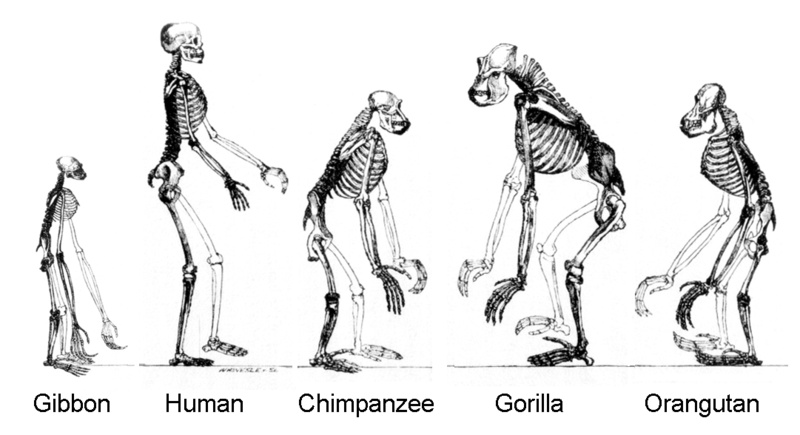Human evolution is a complex and fascinating journey that spans millions of years, shaping the species we are today. The story of our evolution involves a series of significant milestones, from the emergence of early hominids to the development of Homo sapiens. This narrative is intricately woven with biological, environmental, and cultural factors that have influenced the trajectory of human evolution.
The story begins around 6-7 million years ago with the divergence of the hominid lineage from the common ancestor we share with chimpanzees. This split marked the beginning of a unique evolutionary path for our ancestors. The first hominids, known as hominins, were adapted to life in the African forests. Over time, climatic changes and environmental shifts led to the evolution of hominins with characteristics suited to a more open, savannah-like environment.
A crucial figure in early human evolution is Ardipithecus ramidus, dating back to approximately 4.4 million years ago. Ardipithecus is considered a key transitional species, displaying both ape-like and human-like features. This adaptive flexibility allowed them to navigate diverse landscapes and marked a pivotal step toward bipedalism, a defining trait of human evolution.
Around 3.2 million years ago, Australopithecus afarensis, exemplified by the famous fossil “Lucy,” further embraced bipedalism. Bipedalism, or walking on two legs, is a significant adaptation that freed the hands for tool use and manipulation. The emergence of tools played a crucial role in the survival and development of early hominins, aiding in activities such as scavenging and processing food.
The transition from Australopithecus to the genus Homo occurred approximately 2.4 to 2.8 million years ago, marking another critical phase in human evolution. Homo habilis, one of the earliest members of the Homo genus, is associated with the use of stone tools and a larger brain size compared to earlier hominins. This increase in brain size is indicative of the evolutionary trend toward greater cognitive abilities.
The subsequent species, Homo erectus, emerged around 1.9 million years ago and is notable for its widespread geographic distribution. Homo erectus displayed advancements in tool technology, social organization, and adaptation to diverse environments. The controlled use of fire by Homo erectus is a particularly significant development, offering warmth, protection, and a means of cooking food.
Around 300,000 years ago, Homo heidelbergensis appeared, displaying a further increase in brain size and a more sophisticated toolkit. This species is considered a common ancestor for both Homo neanderthalensis (Neanderthals) in Europe and Homo sapiens in Africa.
The rise of Homo sapiens, our direct ancestors, is a pivotal chapter in human evolution. Homo sapiens first appeared in Africa around 200,000 years ago. Key features that distinguish us include a large brain relative to body size, advanced tool technology, and complex social structures. The “Out of Africa” theory suggests that Homo sapiens gradually migrated from Africa to other parts of the world, replacing or assimilating with existing hominin populations.
The development of symbolic thinking, language, and art marked a significant leap in human cognitive abilities. The creation of cave paintings, sculptures, and other forms of symbolic expression reflects the emergence of complex cognitive processes. These cultural expressions also played a role in transmitting knowledge and fostering social bonds within communities.
The Neolithic Revolution, beginning around 10,000 BCE, represents a crucial turning point in human history. This period witnessed the transition from a nomadic, hunter-gatherer lifestyle to settled agriculture and the establishment of permanent communities. The domestication of plants and animals allowed for a stable food supply, leading to population growth and the development of more complex societies.
The advent of agriculture not only transformed the way humans obtained food but also had profound social and cultural implications. It gave rise to surplus resources, specialization of labor, and the emergence of complex social hierarchies. The establishment of permanent settlements laid the foundation for the first civilizations, such as those in Mesopotamia, Egypt, the Indus Valley, and China.
As societies became more complex, so did technological innovations. The Bronze Age, characterized by the use of bronze for tools and weapons, further advanced human capabilities. This period also witnessed the development of writing systems, such as cuneiform in Mesopotamia and hieroglyphics in Egypt, facilitating record-keeping, communication, and the preservation of cultural knowledge.
The Iron Age, following the Bronze Age, saw the widespread use of iron tools and weapons, contributing to increased agricultural productivity and military capabilities. It marked another phase in technological progress and cultural evolution.
Throughout these epochs, human societies experienced interactions, migrations, and exchanges that shaped the cultural landscape. The Silk Road, for instance, facilitated trade and cultural exchange between the East and West, fostering the transfer of ideas, technologies, and goods.
The ancient Greeks made significant contributions to philosophy, mathematics, and the sciences, laying the groundwork for Western intellectual traditions. The Roman Empire, with its vast influence, contributed to the spread of Latin-based languages, governance systems, and engineering marvels.
The medieval period witnessed the rise of feudalism, the spread of Christianity, and the flourishing of Islamic civilizations. Innovations such as the compass and papermaking revolutionized navigation and communication, contributing to the interconnectedness of societies.
The Renaissance, beginning in the 14th century, marked a revival of interest in classical learning and the arts. It spurred advancements in various fields, including science, art, and literature. Figures like Leonardo da Vinci and Galileo Galilei made pioneering contributions to human knowledge.
The Age of Exploration, starting in the 15th century, opened up new frontiers as European powers embarked on maritime journeys to discover and trade with distant lands. This era not only expanded geographical knowledge but also led to the exchange of crops, animals, and cultures in what is known as the Columbian Exchange.
The Scientific Revolution of the 17th century brought about a paradigm shift in understanding the natural world. Thinkers like Copernicus, Galileo, and Newton challenged existing beliefs, paving the way for the development of modern science.
The Enlightenment of the 18th century emphasized reason, individual rights, and scientific inquiry. Philosophers like Voltaire, Rousseau, and Montesquieu advocated for the principles of democracy and human rights, influencing political and social developments.
The Industrial Revolution, starting in the late 18th century, transformed societies through mechanization, urbanization, and the growth of industrial economies. It marked a shift from agrarian and craft-based economies to mass production and technological innovation.
The 19th and 20th centuries saw unprecedented advancements in science, technology, and medicine. The discovery of electricity, the development of the steam engine, and the harnessing of nuclear energy revolutionized industries and transportation. Medical breakthroughs, such as the discovery of antibiotics, significantly improved public health.
The two World Wars of the 20th century had profound and far-reaching consequences. They reshaped geopolitical landscapes, led to technological innovations, and prompted the establishment of international institutions like the United Nations to promote peace and cooperation.
The latter half of the 20th century witnessed the Information Age, marked by the rapid development of computers, the internet, and telecommunications. These advancements revolutionized communication, commerce, and access to information, creating a globally interconnected society.
As we navigate the 21st century, the pace of technological innovation continues to accelerate, with breakthroughs in fields like artificial intelligence, biotechnology, and renewable energy shaping the contemporary landscape. The ongoing digital revolution has transformed the way we live, work, and communicate. The ubiquity of smartphones, the rise of social media, and the advent of big data analytics have interconnected people across the globe, fostering a digital age characterized by instant communication and access to vast amounts of information.
Simultaneously, concerns and challenges have emerged in the 21st century, ranging from environmental sustainability to ethical considerations in emerging technologies. Climate change, driven by human activities, poses a significant threat to the planet, leading to rising temperatures, extreme weather events, and disruptions in ecosystems. Efforts to address these challenges include global initiatives, such as the Paris Agreement, aimed at mitigating climate change and promoting sustainable development.
Biotechnological advancements, including gene editing and personalized medicine, offer new possibilities for treating diseases and enhancing human capabilities. However, they also raise ethical questions about the limits of intervention in the human genome and the potential consequences of altering the fundamental aspects of life.
Artificial intelligence (AI) has become a transformative force in various sectors, from healthcare to finance and transportation. Machine learning algorithms, neural networks, and robotics have enabled unprecedented automation and efficiency. Yet, ethical considerations surrounding AI, including issues of bias, privacy, and accountability, demand careful navigation and regulation to ensure responsible and equitable deployment.
Cultural evolution in the 21st century is characterized by increased globalization and interconnectedness. The exchange of ideas, values, and cultural expressions occurs on a global scale, facilitated by digital platforms and international travel. This interconnectedness brings both opportunities for cross-cultural understanding and challenges related to cultural appropriation and identity preservation.
The concept of identity itself has evolved in the 21st century, with discussions around gender identity, sexual orientation, and cultural diversity gaining prominence. Societal attitudes toward these aspects have shifted, prompting conversations about inclusivity, tolerance, and equal rights. Movements advocating for social justice and equality, such as #MeToo and Black Lives Matter, highlight the ongoing struggles for human rights and dignity.
The 21st century has also witnessed geopolitical shifts and challenges. The rise of emerging powers, economic interdependence, and issues like cybersecurity and global health crises have reshaped international relations. The COVID-19 pandemic, in particular, has underscored the importance of global cooperation in addressing shared challenges.
Technological innovations in space exploration have opened new frontiers, with private companies joining traditional space agencies in advancing space exploration. Ambitious missions to Mars, the study of exoplanets, and the potential for space tourism reflect humanity’s continued fascination with the cosmos.
As we reflect on the journey of human evolution, it is essential to recognize the interconnectedness of our past, present, and future. The ability of Homo sapiens to adapt, innovate, and collaborate has propelled us through millennia of challenges and opportunities. The narrative of human evolution continues to unfold, shaped by scientific discoveries, technological advancements, cultural dynamics, and the collective choices we make as a species.
Looking ahead, the challenges of the 21st century, from climate change to ethical considerations in technology, require a global and interdisciplinary approach. The choices we make today will influence the trajectory of human evolution, impacting not only our species but also the diverse ecosystems we inhabit. As we navigate this complex and dynamic journey, a profound understanding of our evolutionary past serves as a compass, guiding us toward a future where resilience, empathy, and sustainability are paramount.










